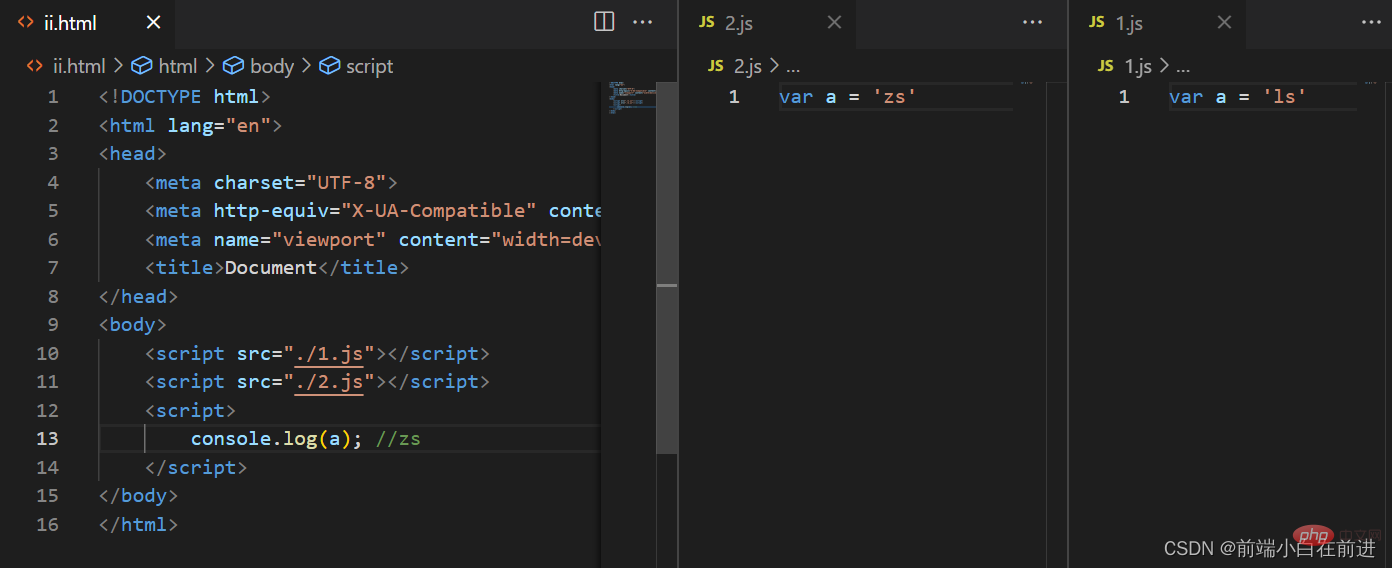What is modularity? An in-depth analysis of node modularization
What is modularity? This article will give you an in-depth analysis of node modularization. I hope it will be helpful to you!

What is modularity
Modularization refers to
solving a complex When solving problems, it is a process of dividing the system into several modules layer by layer from top to bottom. For the entire system, modules are units that can be combined, decomposed and replaced.
The above definition is a bit obscure. Let me give you a simple example: the Overlord game console we played when we were children. When we got tired of playing a game, we It is impossible to directly replace a game console. We can experience various games by changing the game belt. This form is modularization, divides the game into small modules, and when we need it, we can just take it and insert it for use! [Related tutorial recommendations: nodejs video tutorial, Programming teaching】
Modularization in our programming is actually following fixed Rule , split a large file into multiple small modules that are independent and dependent
Benefits of code module splitting:
- Improved the
reusability of the code- Improved the
maintainability of the code- can be implemented on demand
Loading(This is really easy to use!)
##Modular specification
Modular specifications are the rules that need to be followed when splitting and combining code in a modular manner.?1. What syntax format is used toFor example:
reference the module ?2. What syntax format is used in the module Exposing members to the outsideBenefits of modular specifications: everyone complies with the same modular specifications to write code, which reduces the cost of communication and greatly facilitates mutual calls between various modules , Benefit others and yourself. (
)
Module classification in node.jsBased on Node.js Depending on the source of the modules, the modules are divided into 3 major categories, namely:
? 1.Built-in modules
(Built-in modules are officially provided by Node.js, such as fs, path, http, etc.) ? 2. Custom module
(Every .js file created by the user is a custom module) ? 3. Third-party module
(provided by a third party The developed modules are not officially provided built-in modules, nor are they custom modules created by users. They need to be downloaded before use)
require()
method, you can load the requiredbuilt-in modules, user-defined modules, and third-party modules
in the module.for use.Note:When using the require() method to load other modules, the module will be executed. Load the code
Module scope of node.js
# is similar to function scope. Variables, methods and other members defined in a custom module can only be accessedwithin the current module. This module-level access restriction is called module scope.Code example:
//在模块作用域中定义常量 nameconst name = 'qianmo'//在模块作用域中定义函数sing()function sing() {
console.log(`大家好,我是${name}`);}//在测试js文件中加载模块const a = require('./08.模块作用域')console.log(a); // {}. This is because the properties and methods in the module scope are private members and we cannot access them when loading the module!
Benefits of module scopeThere is actually only one benefit of module scope:Prevent the problem of global variable pollution
In the above code, we introduced two js files,  variables are defined in the js files at the same time a
variables are defined in the js files at the same time a
zs, here we can find a problem, the 2.js file overwrites the 1.js, this reflects a problem. When we define global variables, it is easy to cause variable pollution. The modularization of node can help us solve this problem!
向外共享模块作用域中的成员
在每个 .js 自定义模块中都有一个 module 对象,
它里面存储了和当前模块有关的信息
我们打印一下module,console.log(module):

在自定义模块中,可以使用
module.exports对象,将模块内的成员共享出去,供外界使用。
外界用require()方法导入自定义模块时,得到的就是 module.exports 所指向的对象。
代码示例:
// 在默认情况下 module.exports = {}const age = 20//向 module.exports 对象上挂载 name 属性module.exports.name = '正式'//向 module.exports 对象上挂载 sing 方法module.exports.sing = function() {
console.log('hello');}module.exports.age = age//让 module.exports 指向一个全新的对象module.exports = {
username : 'qianmo',
hi() {
console.log('你好啊!');
}}// 在外界使用require 导入一个自定义模块的时候 得到的成员。// 就是 那个模块中,通过 module.exports 指向的那个对象const m1 = require('./11.自定义模块')console.log(m1); // { username: 'qianmo', hi: [Function: hi] }在测试js文件中,我们打印了引入的模块,发现打印出来了
module.exports最后指定的对象
注意:使用 require() 方法导入模块时,导入的结果,永远以 module.exports 指向的对象为准。
由于 module.exports 单词写起来比较复杂,
为了简化向外共享成员的代码,Node 提供了 exports 对象。默认情况下,exports 和 module.exports 指向同一个对象。最终共享的结果,还是以 module.exports 指向的对象为准。
代码示例:
console.log(exports); // {}console.log(module.exports); // {}console.log(exports === module.exports); // true在我们进行对exports对象解析之前,我们需要确定一下exports与module.exports是不是指向的是一个对象,我们可以看出,最后打印出了true,说明exports与module.exports指向的是一个对象!
const username = 'zs'exports.username = username
exports.age = 20exports.sayHello = function() {
console.log('大家好!');}//最终向外共享的结果,永远是 module.exports 所指向的对象const m = require('./13.exports对象')console.log(m); //{ username: 'zs', age: 20, sayHello: [Function (anonymous)] }在上述的代码中,我们在私有模块中定义了属性和方法,我们通过
exports将属性和方法导出,在测试文件中引入,我们会发现,测试文件中打印出了属性和方法。
exports 和 module.exports 的使用误区
时刻谨记,使用
require()引入模块时,得到的永远是module.exports 指向的对象:

- 在第一个图中,module.exports指向一个新对象,所以在测试文件中,只会打印出来
{gender:'男',age:22} - 在第二个图中,虽然exports指向了一个新对象,但是我们知道我们只会打印出来
module.exports指向的对象,所以我们只能打印出来一个属性{username : 'zs'} - 在第三个图中,exports和
module.exports都没有指定一个新对象,我们还知道,在默认情况下exports和module.exports指向的是一个对象,所以最终打印出来{username : 'zs',gender:'男'} - 在第四个图中,exports指向了一个新对象,但是最终这个对象又赋值给了
module.exports,所以,最后打印出了{username:'zs',gender:'男',age:22}
? 注意 : 不要在一个文件中同时使用
exports和module.exports,防止混淆
Node.js 中的模块化规范(commonJS)
Node.js 遵循了
CommonJS 模块化规范,CommonJS 规定了模块的特性和各模块之间如何相互依赖。
CommonJS 规定:
① 每个模块内部,module 变量代表当前模块。
② module 变量是一个对象,它的 exports 属性(即 module.exports)是对外的接口。
③ 加载某个模块,其实是加载该模块的 module.exports 属性。require() 方法用于加载模块。
小结
模块化是node.js最大的特点,在前端的项目开发中,模块化已经成为了必不可少的部分,
我们在vue中使用的组件化其实就是模块化的概念,前端只要学透了模块化,那么你的函数封装能力,按需调用的能力将会大大提升,这样的话将会极大限度的提升你的项目开发效率。
For more node-related knowledge, please visit: nodejs tutorial!
The above is the detailed content of What is modularity? An in-depth analysis of node modularization. For more information, please follow other related articles on the PHP Chinese website!

Hot AI Tools

Undresser.AI Undress
AI-powered app for creating realistic nude photos

AI Clothes Remover
Online AI tool for removing clothes from photos.

Undress AI Tool
Undress images for free

Clothoff.io
AI clothes remover

Video Face Swap
Swap faces in any video effortlessly with our completely free AI face swap tool!

Hot Article

Hot Tools

Notepad++7.3.1
Easy-to-use and free code editor

SublimeText3 Chinese version
Chinese version, very easy to use

Zend Studio 13.0.1
Powerful PHP integrated development environment

Dreamweaver CS6
Visual web development tools

SublimeText3 Mac version
God-level code editing software (SublimeText3)

Hot Topics
 1387
1387
 52
52
 How to use express to handle file upload in node project
Mar 28, 2023 pm 07:28 PM
How to use express to handle file upload in node project
Mar 28, 2023 pm 07:28 PM
How to handle file upload? The following article will introduce to you how to use express to handle file uploads in the node project. I hope it will be helpful to you!
 How to Optimize the Maintainability of Java Code: Experience and Advice
Nov 22, 2023 pm 05:18 PM
How to Optimize the Maintainability of Java Code: Experience and Advice
Nov 22, 2023 pm 05:18 PM
How to Optimize the Maintainability of Java Code: Experience and Advice In the software development process, writing code with good maintainability is crucial. Maintainability means that code can be easily understood, modified, and extended without causing unexpected problems or additional effort. For Java developers, how to optimize the maintainability of code is an important issue. This article will share some experiences and suggestions to help Java developers improve the maintainability of their code. Following standardized naming rules can make the code more readable.
 How to solve the code complexity error in Python code?
Jun 24, 2023 pm 05:43 PM
How to solve the code complexity error in Python code?
Jun 24, 2023 pm 05:43 PM
Python is a simple, easy-to-learn and efficient programming language, but when we write Python code, we may encounter some problems with excessive code complexity. If these problems are not solved, it will make the code difficult to maintain, error-prone, and reduce the readability and scalability of the code. So, in this article, we will discuss how to resolve code complexity error in Python code. Understanding Code Complexity Code complexity is a measure of the nature of code that is difficult to understand and maintain. In Python, there are some indicators that can be used
 An in-depth analysis of Node's process management tool 'pm2”
Apr 03, 2023 pm 06:02 PM
An in-depth analysis of Node's process management tool 'pm2”
Apr 03, 2023 pm 06:02 PM
This article will share with you Node's process management tool "pm2", and talk about why pm2 is needed, how to install and use pm2, I hope it will be helpful to everyone!
 Pi Node Teaching: What is a Pi Node? How to install and set up Pi Node?
Mar 05, 2025 pm 05:57 PM
Pi Node Teaching: What is a Pi Node? How to install and set up Pi Node?
Mar 05, 2025 pm 05:57 PM
Detailed explanation and installation guide for PiNetwork nodes This article will introduce the PiNetwork ecosystem in detail - Pi nodes, a key role in the PiNetwork ecosystem, and provide complete steps for installation and configuration. After the launch of the PiNetwork blockchain test network, Pi nodes have become an important part of many pioneers actively participating in the testing, preparing for the upcoming main network release. If you don’t know PiNetwork yet, please refer to what is Picoin? What is the price for listing? Pi usage, mining and security analysis. What is PiNetwork? The PiNetwork project started in 2019 and owns its exclusive cryptocurrency Pi Coin. The project aims to create a one that everyone can participate
 How to solve the poor maintainability error of Python code?
Jun 25, 2023 am 11:58 AM
How to solve the poor maintainability error of Python code?
Jun 25, 2023 am 11:58 AM
Python, as a high-level programming language, is widely used in software development. Although Python has many advantages, a problem that many Python programmers often face is that the maintainability of the code is poor. The maintainability of Python code includes the legibility, scalability, and reusability of the code. In this article, we will focus on how to solve the problem of poor maintainability of Python code. 1. Code readability Code readability refers to the readability of the code, which is the core of code maintainability.
 Token-based authentication with Angular and Node
Sep 01, 2023 pm 02:01 PM
Token-based authentication with Angular and Node
Sep 01, 2023 pm 02:01 PM
Authentication is one of the most important parts of any web application. This tutorial discusses token-based authentication systems and how they differ from traditional login systems. By the end of this tutorial, you will see a fully working demo written in Angular and Node.js. Traditional Authentication Systems Before moving on to token-based authentication systems, let’s take a look at traditional authentication systems. The user provides their username and password in the login form and clicks Login. After making the request, authenticate the user on the backend by querying the database. If the request is valid, a session is created using the user information obtained from the database, and the session information is returned in the response header so that the session ID is stored in the browser. Provides access to applications subject to
 What is a single sign-on system? How to implement it using nodejs?
Feb 24, 2023 pm 07:33 PM
What is a single sign-on system? How to implement it using nodejs?
Feb 24, 2023 pm 07:33 PM
What is a single sign-on system? How to implement it using nodejs? The following article will introduce to you how to use node to implement a single sign-on system. I hope it will be helpful to you!




